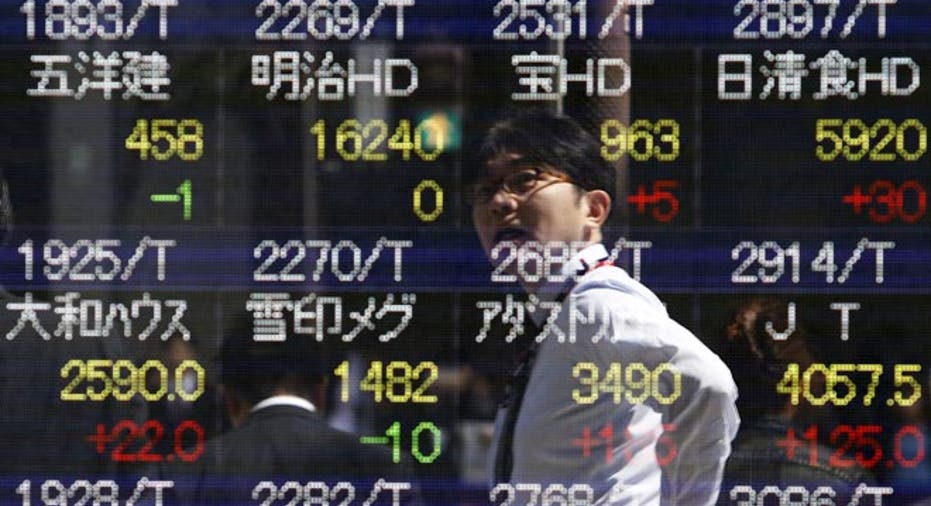U.S. Futures Rise, Asian Shares Waver Ahead of Fed Decision

As of 2:25 a.m. ET, Dow Jones Industrial Average futures were 52 points higher, or 0.32% to 16257. S&P 500 futures gained 6 points, or 0.31% to 1945, while Nasdaq 100 futures added 12 points, or 0.28% to 4296.
(The following is the original story reported by Dow Jones Newswires)
Asian markets got off to a weak start Friday as a rate decision from the U.S. Federal Reserve loomed, although stocks in Hong Kong were headed for their first week of gains in nearly two months.
The Hang Seng Index was on track to rise 4% this week, after seven straight weeks of losses.
Most markets across the region were shaking off recent weakness, with the Nikkei Stock Average headed toward finishing 2.7% higher this week. Even the volatile Shanghai Composite Index was set to rise 1.6%.
On Friday, Shanghai was recently up 0.3% and the Hang Seng Index gained 0.4%. Most other benchmarks were off slightly, although they managed to come off their morning lows.
A summer selloff doused enthusiasm among some fund managers over whether to invest in China's domestic market or stick to the less-restricted offshore market in Hong Kong. Early Saturday in Asia, index provider FTSE Inc. is expected to announce whether it will include Chinese domestic equities into its widely-tracked global benchmarks.
But, a rebound was shaping up, after worries about China's ability to shore up its market and its slowing economy had forced steep declines across the region--shares in Hong Kong and China are both roughly flat this month, having lost roughly 12% in August.
Deutsche Bank said in a recent report that it remains upbeat on the market in Hong Kong, where it expects Chinese stocks to rise about 30% before the end of the year.
Asia markets veered between gains and losses this week, after China's top economic planner on Monday cut the country's growth rate for last year, reinforcing fears that China's slowdown is worse than expected. Trading was particularly rocky in Japan, where the Nikkei plunged Tuesday and went briefly into negative territory for the year, only to jump 7.7% on Wednesday as investors unwound short positions.
As the week progressed, investor focus shifted to an impending Fed decision and what appeared to be a division among U.S. central bank officials over whether to increase rates as early as this month. Until recently, many investors were confident that the central bank would lift rates this month. The Fed's policy-making committee holds a meeting on Sept. 16 and 17.
"At this stage, the debate about will they, won't they, is proving to be more destabilizing for the market than the actual move itself," said Tim Ash, an analyst at Nomura in London.
On Friday, shares elsewhere in Asia-Pacific were mixed after U.S. stocks advanced overnight.
The Nikkei Stock Average was recently down 0.2% and Australia's S&P ASX 200 was off 0.2%.
South Korea's Kospi was down 0.7% after the Bank of Korea kept interest rates unchanged, as expected, for the third straight month.
The country has faced growing pressure for more easing, as sluggish global demand weighs on Korean exports. China's slowdown and recent market turmoil have added to its woes, at a time when Korean domestic demand has also been fragile.
In Japan, investors are trying to gauge the government's appetite for more easing, with stocks down 13% from their late-June peak. The Japanese yen is strengthening as investors have sought yen assets as a haven during the recent turmoil. The Bank of Japan's policy board is scheduled to meet Monday Tuesday, just before the Fed.
Nomura Securities chief FX strategist Yunosuke Ikeda said in a note that Bank of Japan Governor Haruhiko Kuroda is likely to unveil surprise monetary easing measures at that meeting, just as he did in October last year.
The Japanese yen traded as strong as 116.46 against the U.S. dollar in late August. It has since weakened slightly to 120.86 against the U.S. dollar.
Australia's S&P ASX 200 hasn't suffered losses as steep as markets in Japan or China have in recent weeks, but it is on track to finish this week flat.
Goldman Sachs on Friday slashed Australia's growth forecast for next year and warned that the risk of a recession remains elevated. The firm now expects gross domestic product growth of 2.0% in 2016, down from an earlier forecast of 2.25%, adding that the Reserve Bank of Australia might need to lower its benchmark interest rate--already at a record low of 2.0%--another two times.
The Malaysian ringgit rebounded 0.8% to trade at 4.3030 against the U.S. dollar, after hitting a string of 17-year lows.
Kwanwoo Jun and Hiroyuki Kachi contributed to this article.
Write to Chao Deng at Chao.Deng@wsj.com